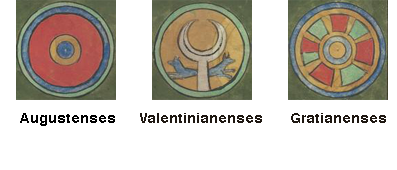
This page created 27 July 2014, and last modified: 26 July 2015 (Maier reference numbers added)

The last of the shield patterns illustrated (17#16) accompanying the list of units under the Magister Militum per Thracias in the eastern half of the empire is labelled (17.q) the Gratianenses. Its shield pattern in various manuscripts is as shown below:

The pattern features a yellow boss (white in M) surrounded by a blue band (white in W); the shield's rim is blue (with a thin white inner rim in M). In between the two blue rims are two yellow concentric rims connected by 7 yellow spokes (6 in M). The sectors between the spokes are asymmetrically coloured. In P and B, starting from the 12 o'clock position and moving clockwise, they are red, green, red, green, red, green and red (half of the sector each), and finally green again (making it look like there should have actually been 8 spokes). In B, the sectors go green, red, green, red, red, green, red. In W they are red, white, red, white, red, white, white; while in M they are red and yellow, red, yellow, red, yellow and red, yellow, again making it look like there should have been 8 spokes.
The Gratianenses, although illustrated under the Magister Militum per Thracias, is not actually listed as such. This would appear to be a simple omission from the Magister's list (18.30.1), since, as Jones says (page 348), the Gratianenses is evidently one of three related units: the Augustenses (18.30, referring to the eastern Augustus, Valens), the Valentinianenses (18.31, after his elder brother Valentinian I, the western Augustus), and the Gratianenses (after Valentinian I's son Gratian, the Caesar), raised and serving together; it is always a possibility, however the units were merely "rebranded" with new names rather than being newly raised. The shield patterns of the three units, despite their related names and being in the same command, are not at all similar, as a comparison of the following patterns taken from the Parisian manuscript shows:

Gratian (Flavius Gratianus Augustus) was the senior western emperor from 375 to 383. Other units named after him recorded in the Notitia are the:
Gratianenses seniores (98/9.56), a unit of auxilia palatina under the Magister Equitum's Gallic commandIn addition there are listed the Auxilium Gratianense (78.16), a unit of auxilia under the Dux Moesiae primae, and the Milites primi Gratianenses (74.17), a unit of auxilia under the Dux Scythiae, but since both of these are stationed at a place called "Gratiana" they are more likely named for their locality, and thus only indirectly, if at all, for the emperor. This is not a large number of units, but still more than named after his uncle, Valens, who appears to have just a single unit directly and clearly named after him in the Notitia: the Tertii sagittarii Valentis (9.31, but see my discussion of the Sagittarii dominici, 12.30; and see also the Secunda Felix Valentis Thebaeorum, 15.23). Note that all the other units named after Gratian are auxiliary units.
Gratianenses iuniores (98/9.64), a unit of auxilia palatina under the Magister Peditum's Italian command
Cohors secunda Gratiana (59.25), a(n auxiliary) cohort under the Dux Palaestinae
Since all the infantry units listed under the Magister Militum per Thracias come under the heading (18.11) "legiones comitatenses", one would expect the Gratianenses to also be a legionary unit; however, this would make the Thracian field force unique in being the only one without any auxilia palatina units, or pseudocomitenses auxilia units for that matter. However, all may not be what it seems. In the Magister Militum per Orientem's list, the two auxilia palatina units there are not actually listed separately as such, but appear under the heading (15.2) "Vexillationes comitatenses", i.e. as cavalry units. Further, the pseudocomitatenses units are also enumerated differently in most manuscripts from what is actually listed. Thus a similar situation may well apply to the Magister Militum per Thracias.
In favour of this, I would posit the Augustenses, the Valentinianenses, and the Gratianenses were actually auxilia units: their names resemble those of auxilia (especially auxilia palatina) units more than they do legionary units (vide supra). A further indication of auxiliary status is the twin-headed (pseudo-) zoomorphic device of the Valentinianenses, which, counting both headless and non-headless variants, is carried by 15 units, of which none are legionary, save the potential example of the Valentinianenses itself. Perhaps these three units, raised together, were added as an illustrated block at the end of the list for simplicity rather than being inserted in the usual place for auxilia palatina (i.e. before the legiones comintatenses), since that would require rewriting (and redrawing) the document. Alternatively, they may simply had not been given auxilia palatina status, and instead have been pseudocomitatenses auxiliary units, in which case they would be correctly positioned, and the only "problem" would be the then relatively minor one of a line labelling them as such (e.g. 18.29.1 "Pseudocomitatenses") being missing. This would also have the added bonus of making the textual omission of the Gratianenses perhaps less surprising. (It may be that the Gratianenses was simply soon removed from the command; this would leave an even number of infantry units, which seems to have been the typical pattern, so as to allow the brigading of units together in pairs.)

Return to the Notitia alphabetical unit list page.
Return to my Notitia index page.